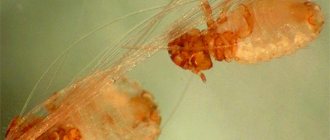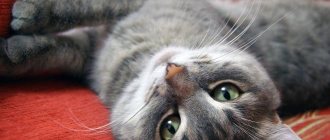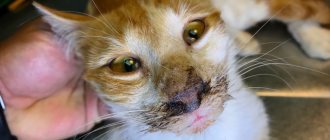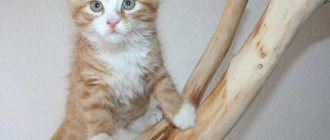There is a common misconception that only people suffer from dermatitis. Unfortunately, this is not the case, because the disease is very common in our pets. In addition, they are susceptible to many other skin irritations, especially during certain times of the year and due to certain circumstances. In this article, experienced specialists from the Murkosha shelter will tell you how to recognize the signs of dermatitis in cats and what measures need to be taken to cure it and prevent the disease from occurring in the future.
1) What is dermatitis in cats 2) Causes of the disease and its types 3) Symptoms of dermatitis in cats 4) Why dermatitis is dangerous for a cat and its owners 5) Treatment and prevention
Is there a genetic predisposition to dermatoses?
Some researchers assign a key role in the development of many diseases to genetic predisposition. (1) Indeed, sometimes dermatoses in cats have a hereditary (breed) predisposition. For example, such as idiopathic dermatitis of the face (Persian and Himalayan cat breeds suffer), ulcerative dermatitis of the nose (observed in Bengal cats), cutaneous mastocytosis (the disease has been reported in Sphynx and Devon Rex cats). (2–5)
It is not known for certain how genetically inherited dermatitis in cats is accompanied by itching (for example, allergic dermatitis). However, itching itself as a condition is extremely debilitating. This is what prompts researchers to study the causes of itching and look for possible options for its control, including medications.
Forms and complications of seborrheic dermatitis
There are pediatric and adult forms of seborrheic dermatitis.
Sometimes the disease is associated with psoriasis (seborrheic psoriasis).
The severity of the disease varies from mild dandruff to severe erythroderma. Dandruff affects the scalp in the hair growth area. In 70% of children, seborrheic dermatitis usually appears by 3 months of age and resolves spontaneously by 6-12 months.
In adults, seborrheic dermatitis begins in adolescence. Predominant in young and elderly people. More often affects men.
Mechanisms of itching formation
In veterinary medicine, the following definition is accepted: itching is an unpleasant sensation that causes the desire to scratch. It should be noted that it was previously assumed that itching and pain (as sensations) are close to each other, since the paths of their development are identical. (6−8) However, over time, researchers have discovered differences in the mechanisms of development of itch and pain. Specifically, findings from positron emission tomography of the brain revealed that the perception of pain is processed by the primary and secondary somatosensory cortices, while the perception of itch is processed by the prefrontal and primary somatosensory cortices, premotor areas, and anterior cingulate cortex. (9–13) Moreover, the areas of the brain that perceive sensitive information about itching and pain largely overlap each other. That is, identical areas that perceive these sensations still exist. Of course, there is still no complete clarity on this issue.
An equally important aspect is to understand which mediators can cause itching, pain and inflammation. It is believed that the predominant mediators of itching are histamine, interleukin-31 and substance P, and the predominant mediators of pain are interleukin-6/-8, tumor necrosis factor, hydrogen ions, calcitonin gene-related peptide, adenosine triphosphate. Mediators that may be involved in the development of both itching and pain include endothelin, tryptase, nerve growth factor, and acetylcholine. Along with this, gastrin-releasing peptide, neurotrophins, kallikreins, proteases, leukotrienes, prostaglandins and other inflammatory mediators that can activate nerve fibers and sensitize them play a role in the development of itching. In addition to IL-31, a number of other interleukins (for example, IL-2,4,13) are also involved in the development of itching. (14–23)
Main causes of itching in cats
In various sources you can find information on data showing the relationship between various dermatitis in cats, including those accompanied by itching. According to the authors of one such publication, there are ten most common skin problems in cats, including:
- flea infestation;
- flea allergy;
- dermatophytosis;
- otodectosis;
- food allergies;
- allergies to environmental allergens;
- hypersensitivity caused by other factors (when the causes are not established);
- otitis;
- superficial bacterial skin infection;
- psychogenic alopecia. (24)
According to a study on hypersensitivity dermatitis in cats, itching may be caused by:
- flea allergy – in 29% of cases;
- food allergies – in 12% of cases;
- allergies to environmental allergens – in 20% of cases;
- hypersensitivity caused by various other factors (when the causes have not been established) - in 15% of cases;
- other diseases (ectoparasitic, autoimmune, fungal, tumor, psychogenic, viral, bacterial, idiopathic, as well as external otitis) - in 24% of cases. (25)
There are probably four main groups of causes that cause itching in cats:
- parasitic skin diseases;
- skin infections (bacterial and fungal);
- allergies (to flea saliva, to food factors, to environmental allergens);
- other (including rare) skin diseases (mastocytoma, mastocytosis, some viral infections, psychogenic itching and others).
First aid
The owner must provide the pet suffering from dermatitis with the most comfortable conditions and strictly follow all the veterinarian’s recommendations. Self-medication will cause irreparable harm to health, because the allergen that provoked the disease may well be hidden in the home medicine cabinet. Under no circumstances should you independently select or change medications prescribed by a veterinarian, or reduce or increase the dosage!
As first aid, you can give your four-legged pet the “Stop Itching” suspension to weaken the effect of the irritant. You should not smear the affected areas of the skin with anything, as this will significantly complicate the diagnosis in a veterinary clinic.
To prevent your cat from picking at sores, lightly file his claws and put on a light blanket to prevent infection from entering the wounds.
Swelling of the paws indicates that the dermatitis is most likely caused by an allergy to cat litter. In this case, you need to replace the contents of the tray, choosing a composition without small particles and odorless.
Clinical manifestations of itching in cats
In cats, with most dermatitis accompanied by itching, one of the so-called clinical patterns can be detected. Among these patterns are:
- miliary dermatitis (a rash consisting of papules that may be covered with yellowish crusts; photo 1);
Photo 1. Miliary dermatitis
- self-induced (self-induced) alopecia (loss of hair in places where they are normally present, caused by the patient’s actions: combing, licking, etc.; photo 2);
Photo 2. Self-induced alopecia
- itching in the head/neck area (photo 3), usually accompanied by excoriation (scratching);
Photo 3. Itching in the scalp
- eosinophilic granuloma complex, or eosinophilic dermatitis.
We should tell you more about the last pattern. Eosinophilic granuloma complex is a collective term used to refer to a group of lesions in cats that can be found on the skin, mucous membranes, and skin-mucous interface. Histological examination of such lesions reveals eosinophils. The most likely causes of their occurrence are allergies (to insect bites, to food, etc.). Among the lesions from this group in cats are:
- Indolent (eosinophilic) ulcers (Photo 3) are lesions that typically occur on the skin and mucous membranes of the lips in cats. As a rule, ulceration is painless, but may be accompanied by the development of a secondary bacterial infection;
- eosinophilic plaques are usually multiple lesions raised above the surface of the skin, often erythematous (reddened), may be ulcerated, and also have necrotic changes in the form of a whitish coating on their surface. The size of these lesions can reach several centimeters. Accompanied by itching;
- eosinophilic granulomas are lesions that are found on the skin, mucous membranes and at the interface of the skin and mucous membranes. Can be quite large in size (for example, linear granuloma can be observed along the entire length of the caudal surface of the femurs in cats). On palpation these are dense lesions. They rise above the surface of the skin and can be round, oval, or linear in shape; may have an erythematous or yellowish color. Often accompanied by itching. In the oral cavity, they can be found both on the mucous membranes of the palate and on the tongue, and have signs of ulceration and necrosis. They got their name due to the fact that histological examination, in addition to eosinophils, reveals signs of granulomatous dermatitis. (26)
Photo 4. Indolent ulcer
The listed clinical patterns can be observed individually or in one or another combination in one patient. This feature of clinical manifestations, with all the variety of skin diseases with itching, can allow the use of clinical criteria only as an auxiliary and weak diagnostic tool.
Treatment of miliary dermatitis
The therapeutic actions of a veterinary dermatologist directly depend on the identified cause of the development of miliary dermatitis. For bacterial infections, systemic and antibacterial drugs are prescribed. Chlorhexidine, silver sulfadiazine, and fusidic acid are effective as local treatments; the drugs are applied locally to the area of accumulation of papules. For extensive lesions, it is necessary to apply the product to the cat’s entire body.
All medications are prescribed by the attending physician based on the identified cause of miliary dermatitis. Self-prescription is unacceptable, especially since it is not effective to act only on skin manifestations.
If you notice that your cat has begun to show excessive attention to the cleanliness of its fur, scratches itself, and when stroking small grains of dry papules under your fingers, don’t hesitate! Call the RosVet VC by phone, 24 hours a day. Make an appointment with a veterinary dermatologist; the clinic accepts animals 24 hours a day.
Clinical approach to a cat with pruritus
It is probably a given that once a practitioner has encountered a cat suffering from itching, he cannot know anything about the cause that led to it. The only thing that is possible in this case is to make a list of differential diagnoses.
This is a key aspect on which the authors of various scientific publications focus the attention of readers. For example, in one of the articles devoted to allergies to environmental allergens, you can find a logical statement: before discussing this diagnosis, other causes of itching and dermatitis should be excluded. The authors suggest taking into account the following diseases, depending on the nature of the skin manifestations:
- for miliary dermatitis:
flea allergy, food allergy, dermatophyte infection, bacterial folliculitis, otodectosis, cheyletiellosis, pemphigus foliaceus, drug reaction; - for self-induced alopecia:
flea allergy, food allergy, demodicosis (caused by D. gatoi), dermatophyte infection, Malassezia dermatitis, psychogenic alopecia, lower urinary tract disease; - for itching in the head/neck area:
flea allergy, food allergy, demodicosis (caused by D. gatoi), notoedrosis, otodectosis, dermatophyte infection, superficial and deep bacterial skin infection, Malassezia dermatitis, viral infections (herpesvirus, papillomavirus, calicivirus, poxvirus, caused by feline leukemia virus), skin neoplasms (lymphoma, mastocytoma, squamous cell carcinoma), adverse reaction to the use of drops for treatment against ectoparasites, drug reaction, pemphigus foliaceus; - with eosinophilic granuloma complex:
flea allergy, food allergy, infections caused by mycobacteria, nocardiosis, fungal diseases (sporotrichosis), viral diseases, skin neoplasms (lymphoma, mastocytoma, squamous cell carcinoma), deep bacterial skin infection, diseases accompanied by the formation of sterile granulomas ( for example, xanthomatosis). (27)
Thus, the list of possible causes of dermatitis accompanied by itching in cats is quite extensive. It should be noted that itching may not occur in all cases: for example, in the presence of indolent ulcers in cats, the affected area of the lips usually does not cause visible concern and can only occur in the presence of a secondary bacterial infection. Since it is impossible to establish a diagnosis based only on clinical symptoms, a so-called step-by-step algorithm is carried out.
Diet
Diet is very important for the prevention of dermatitis and their treatment in both adults and children. Foods that provoke allergies should be excluded from the menu: citrus fruits, nuts, red fish, eggs, chocolate, honey. It is recommended to limit irritating foods as much as possible - spices, vinegar, salty, spicy and smoked foods. Patients are advised to take light soups, low-fat foods, and fermented milk products. It is necessary to drink enough water.
For infants suffering from atopic dermatitis, it is advisable to continue breastfeeding. At the same time, the mother should exclude allergens from her food as much as possible. If breastfeeding is not possible, the child is prescribed special formulas with a minimum content of cow's milk protein. Complementary feeding is introduced to such children as late as possible, with extreme caution. Each new product and the reaction to it should be recorded in a food diary.
Article sources:
- Characteristics of seborrheic dermatitis. Shukurov I.B., Yakhshieva M.F., Rustamov M.K. Scientific journal, 2018
- Atopic dermatitis of adults. Dvoryankova E., Denisova E., Piruzyan A., Korsunskaya I. Doctor No. 3, 2021. p. 9-13
- Maintenance pharmacotherapy for atopic dermatitis. Petrova I.V., Omarov N.N., Sargsyan M.S., Khamroeva S.A., Osmanova Z.S., Proshin S.N. Reviews on clinical pharmacology and drug therapy, 2021. p. 60-63
Diagnostic algorithm for itching in cats
This algorithm is not much different from that for dogs and assumes:
- taking anamnesis;
- clinical examination;
- conducting routine dermatological tests to exclude parasites, infections and other (rare) causes leading to the development of dermatitis accompanied by itching.
In some clinical cases, diagnosis will require a fine-needle biopsy and additional diagnostic tests (PCR, histological examination of the skin and some others).
Prevention measures
The following preventive measures will help significantly minimize the risk of developing dermatitis:
- regular antiparasitic treatment of your pet;
- limiting contact with stray, sick animals;
- maintaining hygiene in the place where the cat is kept (timely cleaning of the bed, changing the litter in the tray) in the house as a whole;
- a balanced diet, for animals with allergies - following a diet and careful use of medications;
- storage of chemicals and household chemicals in inaccessible places;
- regular examinations of the skin, and at the first symptoms of dermatitis - a visit to the veterinarian.
Dermatological tests performed at the initial appointment of a cat with itching
Speaking about routine dermatological tests, we should mention LUM diagnostics, trichogram, skin scrapings, tape test, ear smears, smears from the surface of skin lesions, wet paper test (photo 4), culture on nutrient media to exclude dermatophytoses . In some cases, visual inspection using a magnifying glass may be used.
Photo 5. A wet paper test helps determine the presence of a flea infestation.
Routine diagnostics will exclude the presence of:
- flea infestation;
- pediculosis;
- notoedrosis;
- cheyletiellosis;
- otodectosis;
- thrombiculosis;
- demodicosis, including that caused by D. gatoi. Note that in some cases it is impossible to detect the parasite D. gatoi, and therefore a “test treatment” can be carried out with a drug for cats from the isoxazoline group;
- dermatophyte infection, which in some cases may be accompanied by itching (photo 5).
Photo 6. Trichogramma. Hair affected by dermatophytes
Identifying the causes of allergies in cats
If there is no evidence that the patient has parasites, skin infections, or rare diseases, then further diagnostic actions are aimed at excluding various causes of allergies.
Flea allergic dermatitis
This is a common cause of itching in cats. It may be accompanied by other causes of allergies in cats (food allergies and feline atopic syndrome).
In most cases, flea dermatitis in cats is not accompanied by flea infestation, so most often it is not possible to visually determine the presence of a problem such as an allergy to flea bites. Therefore, appropriate treatments of the premises are carried out; cats/cats with itching, as well as all animals in contact with her/them.
Pyrethroids and insect growth regulators are commonly used for indoor treatment. Neonicotinoids, phenylpyrazoles, macrocyclic lactones, isoxazolines and insect growth regulators, which are part of complex preparations, are used to treat cats.
To confidently exclude the presence of flea allergic dermatitis, treatment procedures are carried out from 9 to 12 weeks. (27)
Food allergies
Food allergies in cats should be eliminated through an elimination diet. For this purpose, diets with a new source of protein, as well as hydrolysis diets, can be used.
In some cases, transferring cats to diagnostic diets is impossible due to the animals’ refusal to accept the proposed diet. Practical experience indicates that the soy hydrolysis diet PRO PLAN® VETERINARY DIETS HA ST/OX HYPOALLERGENIC has an obvious advantage in this regard - it is perfectly consumed by cats. In addition, the food is balanced in terms of the presence of nutrients cats need, which is important and is an additional incentive for the doctor when choosing a product for diagnosing food allergies. The diet is prescribed to cats for a period of 8 to 10 weeks; some doctors use the diagnostic diet for a longer period – up to 12–13 weeks. After this time, the patient's clinical condition is assessed. If symptoms of itching and inflammation are absent or they are much less pronounced than at the time of starting the diet, cats are given a food challenge, which usually lasts 2 weeks. For a challenge test, the diet that preceded the elimination diet is usually used. Symptoms may return quickly (within days or even minutes) or increase gradually. (27)
It is important to note: if the doctor uses medications to relieve itching and inflammation, they must be discontinued until the elimination diet is completed. Depending on the severity of symptoms and the drug used, this discontinuation may occur 1 to 3 weeks before clinical evaluation of the patient.
It should also be mentioned that usually both diagnostic steps - ruling out flea and food allergies - are carried out simultaneously. Their beginning and end usually coincide in time, i.e. flea treatment and diet begin on the same day and last, for example, exactly 10 weeks.
Adverse food reactions (ADR), including food allergies, are quite common in dogs and cats. Thus, according to one of the publications, for the creation of which the authors evaluated several hundred different scientific articles, the share of undesirable food reactions that are accompanied by skin lesions in dogs accounts for:
- 1% of the total number of diseases;
- 5% of all skin diseases;
- 15%–20% of the number of diseases accompanied by itching;
- 10%–25% for allergic skin diseases.
In addition, according to various estimates, about a third of dogs suffer from atopic dermatitis (in general, all these figures are similar to those in cats). (28)
Because the symptoms of ADRs are similar to allergies to environmental allergens, (27) it is critical to use strict diets to diagnose adverse food reactions to avoid diagnostic errors.
Feline atopic skin syndrome (FASS) is a diagnosis of exclusion
The concept of “feline atopic syndrome”
(Feline atopic syndrome, FAS) is associated with a number of diseases associated with hypersensitivity. The clinical manifestations of these diseases are very diverse. The pathological process may involve the skin, gastrointestinal tract, and respiratory system. In some cases, a combination of different symptoms is possible. For example, one patient may have skin lesions and asthma.
Feline atopic skin syndrome
Feline atopic skin syndrome (FASS), a newly introduced term (in place of the previously used atopic dermatitis), refers to the skin manifestations of hypersensitivity, usually associated with a reaction to environmental allergens, although food allergies may also be a cause. (27)
ACC is established based on the exclusion of all other causes of itching in cats. If such a diagnosis is established, and the practitioner does not consider it necessary to use additional diagnostics, then treatment includes drug therapy aimed at relieving itching and inflammation of the skin.
If the doctor considers it necessary to include allergen-specific immunotherapy (ASIT) in the treatment regimen, then this requires subsequent diagnostics. It consists of either skin or serum tests (Figure 1, Photo 6). They are necessary to identify environmental allergens that cause ASCVD for the purpose of vaccination with them (carrying out ASIT).
Photo 7. Skin tests. Test result evaluation
Figure 1. The result of a blood serum test in a cat. An increase in IgE levels against allergens of house dust mites and fleas was detected
Treatment method and prognosis
The sooner the fight against dermatitis is started, the higher the chances of successful recovery. Ideally, therapy is carried out without waiting for the inflamed skin to harden and become thicker. This means that the disease has become chronic and will be more difficult to cope with. The main type of drug therapy is anti-itch drugs. The following means are used:
- Antihistamines (Fenistil, Tavegil, Clarotadine) - subcutaneously, orally. The active ingredient is hydrocortisone. Most effective for allergic dermatitis, but prohibited for infection.
- Stop Itching ointment is a complex product with anti-inflammatory, antipruritic and antibacterial properties.
- Medicines containing aluminum. Alusprey gives good results, accelerating the regeneration of damaged tissues and having an antiseptic and anti-inflammatory effect.
In case of traumatic dermatitis, the necessary measure is to treat the affected areas of the skin (abrasions, scratches, etc.) with an alcohol solution of iodine. You can use compresses with Vishnevsky ointment, lotions with disinfecting and astringent components.
Veterinarians warn: frequent use of highly irritating compounds and alcohol solutions can provoke drug-induced dermatitis. When it occurs, you need to use emollient and disinfectant ointments, such as Solcoseryl, salicylic-zinc, syntomycin. Creams based on propolis give a good effect.
If traumatic dermatitis turns into bacterial, then the infected area is treated with chlorhexidine and covered with antibiotic powder on top. The wool is pre-cut, exudate and dried crusts are removed. If the animal is in serious condition, accompanied by lack of appetite, lethargy, and high fever, antibiotic therapy in the form of injections cannot be avoided. The task is to prevent the introduction of a secondary infection into the process and stop purulent complications.
For infectious dermatitis, which is caused by pathogenic fungi, antifungal agents, antibiotics, as well as anti-inflammatory drugs Prednisolone, Dexamethasone are used.
If exposed to harmful substances that cause chemical dermatitis, it is necessary to rinse the skin with cold water. Rinsing should be carried out for at least 10 minutes, using a good jet pressure. Next, the substance itself should be neutralized, for which the affected areas are treated with a weak vinegar solution. Alternatively, you can use citric acid, baking soda.
If a cat suffers from allergic dermatitis, then it is transferred to a hypoallergenic therapeutic diet prescribed by a veterinarian. Modern manufacturers of cat food offer a wide selection of specialized premium and super-premium food that can solve this problem.
As for superficial dermatitis, if it does not go away on its own, then the area of skin that has been exposed to frostbite or burns should be sprayed with a special spray.
To eliminate the possibility of scratching and, accordingly, injury to the skin, it is advisable to use a medical bandage or a protective collar, which should be fixed on the cat’s neck.
Among other things, it is necessary to strengthen the pet’s immune system, for which an obligatory stage of therapy is the use of immunostimulants. As a rule, veterinarians recommend Immunol Vet, Gamavit, Glycopin, Gamapren.
You also need to treat your pet against insects using antiparasitic agents.
The specialist must monitor the treatment process in order to make adjustments if necessary - change the medication, dosage.
As for the prognosis, if therapy is started in a timely manner, it is favorable.
Possible complications include the transition of dermatitis to a chronic form, weakening of the immune system, which makes the pet vulnerable to various diseases. Allergic dermatitis, which occurs as a result of a reaction to an irritating substance, is considered the most dangerous for cats. The lack of medical assistance is fraught with the development of Quincke's edema, which leads to death from suffocation.
Drug therapy aimed at relieving itching and inflammation of the skin
Experts from the International Committee on Allergic Diseases in Animals assessed the effectiveness of a number of products that can be used to relieve itching and inflammation of the skin (the publication was devoted to feline atopic syndrome). (29) The authors of the article concluded that glucocorticoids should be considered effective. Possible recommendations may be the use of methylprednisolone at a dose of 1.5 mg/kg/day or triamcinalone at a dose of 0.18 mg/kg/day. Upon achieving remission, it is necessary to strive for the minimum effective dose (for example, the amount of glucocorticoids used can be reduced to 25% relative to the initial dosage). It is advisable to give these drugs as infrequently as possible to maintain clinical effect. Cyclosporine should also be considered effective. This drug is given in an amount of 7 mg/kg once daily. Its dose can be reduced to twice a week in more than 50% of patients. Oclacitinib is considered to be moderately effective (itching is relieved in approximately 50% of cases). It is usually used at a dosage of about 1 mg/kg every 24 hours or every 12 hours. This drug is registered only for dogs. There are also no long-term studies regarding its use in cats. (29)











